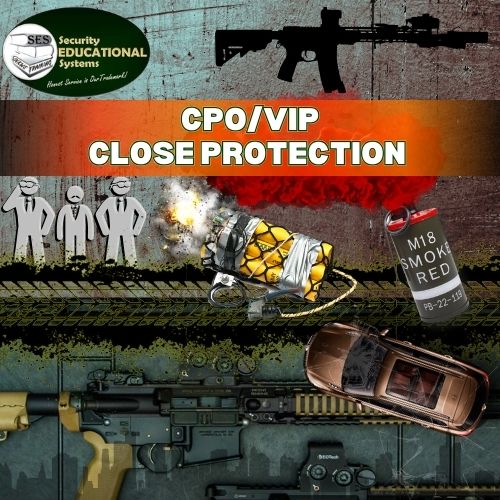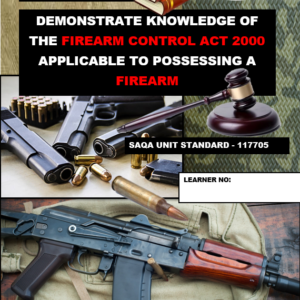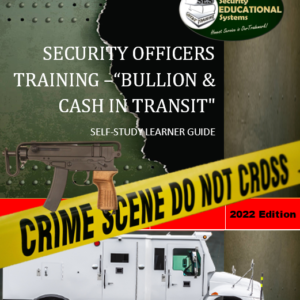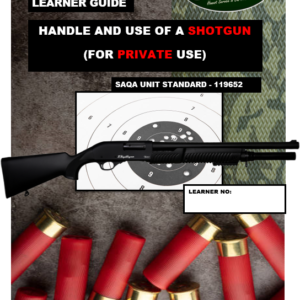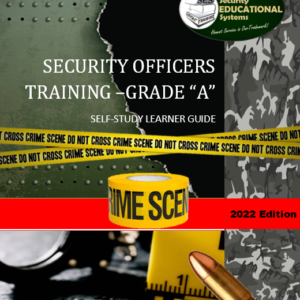SAQA US ID | OCCUPATIONAL CERTIFICATE |
118746 | Occupational Certificate: Close Protector |
This qualification is made up of compulsory Knowledge, Practical Skill and Work Experience Modules: |
Knowledge Modules
|
Practical Skill Modules
|
Work Experience Modules
|
TOTAL TIMELINES FOR THIS PROGRAMME : 520 NOTIONAL HOURS | |
KNOWLEDGE MODULES PRACTICAL MODULES WORK EXPERIENCE MODULES | NOTIONAL 170 HOURS NOTIONAL 210 HOURS NOTIONAL 140 HOURS |
This programme also includes a PRACTICAL END OF COURSE EXERCISE of a week.
The learner will also be required to undergo an EXTERNAL ASSESSMENT for the duration of 2 x DAYS
PROGRAMME OVERVIEW
Purpose:
The purpose of this qualification is to prepare a learner to operate as a Close Protector. A Close Protector proactively and reactively facilitates safety and security of a defined client, whilst on foot, in a venue or vehicle, effectively rendering these environments more secure with respect to physical threats, harassment, embarrassment and discomfort with minimal impact on the client’s daily activities.
A qualified learner will be able to:
- Provide close protection to a designated principal within the close protection environment.
Rationale:
The security sector plays an integral part in South Africa as it assists the law enforcement sector with a sustained environment in which crime is prevented and deterred. It is therefore, vital to ensure that persons within the ambit of private and public close protection are adequately trained and educated in terms of their competencies, skills and values. The security domain is divided into different sectors of which close protection is one.
Close protection is a vital domain of security as it provides protection services to public and private figures such as high-ranking governmental officials and dignitaries. The creation of a safe and secure environment for these public and private figures is important as it creates a stable platform for them to fulfil their mandates and roles. Without their safety they would be unable to contribute to the country on various levels including, political, business, and scientific, Non-Governmental Organisations (NGOs) and entertainment levels. While the general security of the society in the country plays an important role to ensure that all citizens are secured and protected, it is of national interest that individuals such as business leaders, diplomats, dignitaries, celebrities, and the general public are protected. Therefore, this qualification plays a pivotal role in fulfilling the need for a safe and protected environment. This qualification will enable learners to gain knowledge and skills to assist principal(s) to live their lives in a safe and secure environment. The importance and impact of Close Protection in South Africa is significant, especially with the current development initiatives by government to improve the economy of the country, for example, protection of dignitaries from other countries visiting the South African government, international sporting events and concerts where protection is needed for both individuals and spectators. Close protectors are often the first ambassadors of South Africa that influential persons will meet on their first arrival into the country and therefore the Close Protectors need to be suitably trained and capable of performing the required task at the expected professional levels.
Most learners endeavouring to complete this qualification may come from the law enforcement, defence and private security sector. Many of them would have completed a qualification in basic security aspects and will then move on to complete this qualification as it forms an area of specialisation within the security sector. However, this qualification has also been designed to allow learners who have no previous experience to access the sector. Learners entering this qualification will be able to progress vertically from generic security and law enforcement services qualifications to more specialised close protection services as well as articulate horizontally to security management practices, bomb disposal, policing, special combat capabilities and certain emergency medical care qualifications, within the prevailing regulations and legal prescripts.
The qualification facilitates access to education, training and a career path within the close protection services thus developing a pool of qualified, professional close protection personnel. Upon completion of the qualification, learner will be able to gather Protective Information within the close protection environment; determine and organise logistics within the close protection environment; conduct planning within the close protection environment; implement protective measures within the close protection environment and conduct demobilisation; administration and debrief of a close protection operational task. In addition to these, learners will also gain valuable skills in terms of conflict management, protocol, etiquette, diplomacy and threat and risk analysis. This will enable learners to manage difficult and sensitive situations. The qualification has a minimum of 52 credits. The nature of occupation is such that it only requires training for competence over the period of 520 notional hours. This qualification addresses the critical niche in the security industry with limited competencies wherein there are no registered qualifications on the NQF currently.
EXIT LEVEL OUTCOMES
- Gather protective information within the close protection environment.
- Determine and organise logistics within the close protection environment.
- Conduct planning and coordination activities for venues within the close protection.
- Conduct planning and coordination activities for transit movements within the close protection.
- Implement Close Protective measures to a defined principal at venues within the close protection environment.
- Implement close protective measures to a defined principal in transit.
ASSOCIATED ASSESSMENT CRITERIA
Associated Assessment Criteria for Exit Level Outcome 1:
- Conduct a risk assessment.
- Compile principal profile.
Associated Assessment Criteria for Exit Level Outcome 2:
- Organise and arrange necessary accommodation related to the close protection task.
- Organise and arrange necessary travel related to the close protection task.
- Identify and arrange specialised equipment related to the close protection tasks.
- Establish and arrange required support services to the close protection task.
Associated Assessment Criteria for Exit Level Outcome 3:
- Perform planning and coordination activities for venue protections.
- Perform planning and coordination activities for pedestrian protection at venues.
Associated Assessment Criteria for Exit Level Outcome 4:
- Perform planning and coordination activities for transit protection.
- Planning and coordination activities for embus and debus of a principal are performed.
Associated Assessment Criteria for Exit Level Outcome 5:
- Implement close protective measures to a defined principal at venues.
- Implement close protective measures to a defined principal whilst on foot.
- De-escalate and/or control interpersonal conflict situations within the close protection environment.
- Appropriately deal with emergency situations within the close protection environment.
Associated Assessment Criteria for Exit Level Outcome 6:
- Implement close protective measures to a defined principal whilst in transit.
- Implement close protective measures to a defined principal whilst embussing and debussing.
- De-escalate and/or control interpersonal conflict situations within the close protection environment.
- Appropriately deal with emergency situations within the close protection environment.
Integrated Assessment:
Integrated Formative Assessment The skills development provider will use the curriculum to guide them on the stipulated internal assessment criteria and weighting. They will also apply the scope of practical skills and applied knowledge as stipulated by the internal assessment criteria. This formative assessment together with work experience leads to entrance in the integrated external summative assessment.
Integrated Summative Assessment
An external integrated summative assessment, conducted through the relevant QCTO Assessment Quality Partner is required for the issuing of this qualification. The external integrated summative assessment will focus on the exit level outcomes and associated assessment criteria.
The assessment will be conducted through written assessment and the evaluation of practical tasks at decentralised approved assessment sites by a panel of assessors evaluated by assessor(s) registered with the AQP within a period of 1 day.
Specific Outcomes
Specific Outcomes describe what the learner has to be able to do successfully at the end of this learning experience.
Assessment Criteria
The only way to establish whether a learner is competent and has accomplished the specific outcomes is through the assessment process. Assessment involves collecting and interpreting evidence about the learners’ ability to perform a task.
This programme includes assessments in the form of self-assessments, group tasks, quizzes, projects and a practical training programme whereby you are required to perform tasks and collect information to be presented as the portfolio of evidence, proof signed by you the Learner that you have successfully performed these tasks.
To Qualify
To qualify and receive credits towards your qualification, a registered Assessor will conduct an evaluation and assessment of your portfolio of evidence and competency.
Range Of Learning
This describes the situation and circumstance in which competency must be demonstrated and the parameters in which the learner operates.
Responsibility
The responsibility of learning rests with you, so…
- Be pro-active and ask questions
- Seek assistance and help from your Facilitator, if required
How You Will Learn
The programme includes learner presentations, readings, individual activities, group discussions and skill application exercises.
Know what you want to get out of the programme from the start and start applying your new skills immediately. Participate as much as possible so that learning will be interactive and stimulating.
How You Will Be Assessed
This programme has been aligned to registered modules. You will be assessed against the outcomes of the modules by completing a knowledge assignment that covers the essential embedded knowledge stipulated in the programme, and by compiling a portfolio of evidence that provides proof of your ability to apply the learning to your work situation.
When you are assessed as competent against the modules, you will receive credits towards your National Qualification.

